My Moms Gyoza, Game 3
How often have I started a blog post with, “I love ____ ! It’s absolutely my favorite childhood food that my mom used to make for us.”
If you’ve been following my blog, I think you would agree that I have a lot of favorite childhoods foods, more than you could count on one hand, and if I really think about this, it’s very hard for me to pick just one food that is my absolute favorite because my mom lovingly made so many delicious foods for us!
So yet another dish that I absolutely cannot live with and love so dearly is my mom’s gyoza. As a child, I could eat at least 10 of these at one sitting. Today, I’m positive I can eat more than 10, given last night I made 35 gyoza and between bebe dada and I we ate all but three. On the childhood favorite foods ranking, gyoza ranks very high at the top, along with mom’s chawan mushi.
Growing up, we ate gyoza regularly, simply served with rice and nori-tamago sumashijiru (post forthcoming). Gyoza night was one of those meals where, for some reason, salad just didn’t compliment the meal. I’m sure my mom made small salads for us, but all I really remember eating is the gyoza, rice, and sumashijiru. There’s something about a meal of gyoza, a little brown rice, and hot soup that just warms my soul and makes my stomach perfectly happy and content.
After a week of eating lasagna and enchiladas, including leftovers, I was craving Japanese food, specifically, gyoza. I had all the ingredients at home, with the exception of nira and garlic, but the last time I was at the Korean supermarket I saw Chinese chives and Korean chives, but not nira. The Chinese chives and Korean chives looked identical, with the exception that the Chinese chives were longer in length, and they both looked very similar to nira but I wasn’t sure if they were all the same. So before I went grocery shopping, I Googled.
My research uncovered that nira, in English, translates to garlic chives. This is also known as Chinese chives or Korean chives, but differs from chives as we know them here in America. Nira, or garlic chives, have a distinct, pungent aroma of garlic when sliced and also in flavor when cooked, more so than American chives.
I really enjoy writing my posts on Japanese or other Asian foods because it gives me the opportunity to Google. (I know, I am a nerd.) I Googled “gyoza” and discovered that the Japanese potsticker was thought to have originated in the 17th century from China, and the term “gyoza” is derived from the Japanese reading of “Jiaozi”, the mandarin word for dumpling. :)
While I’ve eaten lots of gyoza over my life time, whether at ramen restaurants in the U.S. or in Japan, even frozen (you name it), what I appreciate most about my mom’s gyoza is that it’s meaty. Yes, meat-y. I’m always disappointed when I order gyoza at a restaurant, only to discover that it is mostly cabbage filler, with very little meat. And you know what, cabbage-filler gyoza is almost as disappointing as when the Lakers lose a basketball game, especially when it’s Game 3 of the Western Championship Finals. A 118-109 loss against the Suns with Lamar (we’re on a first-name basis with the boys) fouling out, and even worse, it was the end to an 8-game play-off winning streak.
Yes, WOE is me…
There is something about the morning after a Lakers loss that puts me in a serious funk. Despite the fact that bebe dada and I enjoyed a stellar gyoza dinner, there was no celebrating with Pink Berry for dessert after the game, no happy cheers of, “Yay! We’re one game closer to the NBA Finals!” No clapping with bebe E, who recently claps on que when I say, “Yay!” We just looked at each other and said, “Ok, let’s bathe the bebe and get ready to watch the series finale episode of Lost.” **Sigh.** Even Lost was a disappointment, although 3 seasons ago I was somewhat certain they were all… well, you know.
While mom’s gyoza dinner was not celebratory as I hoped it would be, it was delicious nonetheless. May this recipe bring you a happy stomach, and not another Lakers loss. :)
Mom’s Gyoza
(makes approximately 135)
- 1 pound lean ground beef
- 1 pound ground pork
- 2 – 3 cups chopped nira (garlic chives, aka Chinese chives or Korean chives)
- 1 cup chopped negi (green onions, aka scallion, spring onions
- 4 -5 garlic, finely chopped
- 1 large clump of ginger, finely chopped
- 1/2 cabbage, chopped finely
- 6 – 8 nappa cabbage leaves chopped finely
- 2 1/2 tablespoons sesame oil
- 2 1/2 tablespoon shoyu (soy sauce)
- a few dashes of salt
- a few dashes of pepper
- 2 packs gyoza wrappers
- Canola oil for pan frying gyoza
- Water for steaming gyoza
Whenever I make gyoza, I make extra gyoza meat and freeze this, or I’ll wrap the meat to make extra ready-to-cook gyoza and freeze these for a quick lunch or dinner. The recipe above should easily feed 6 people.
1) Chop nira, negi, ginger and garlic. Set this aside.
2) Chop cabbage and nappa cabbage in to very small, fine pieces. Place in a bowl and microwave on high for 1 minute. The cabbage should cook slightly, and water will be released. Place the cabbage in a towel or cheese cloth and squeeze all of the excess water out.
3) In a large bowl, combine the meat, cabbage and chopped ingredients. Season with sesame oil, soy sauce and a dash of salt and pepper. I use my hands to mix the meat with all of the vegetables and seasonings. This is how my mom does it, and it just seems to work better this way. I mash all the ingredients together with the meat.
4) Set-up your gyoza wrapping station. :) My mom uses a big sheet of wax paper and lays this on the table so she can sit while she makes the gyoza. I definitely recommend sitting, especially if you’re going to be making gyoza for more than just one person. It takes time until you get the hang of it, and trust me, it’s much more comfortable if you’re seated. You’ll also need a spoon to scoop the meat, as well as a small bowl of water and a butter knife.
5) I like to mass-produce my gyoza in assembly-line fashion. I feel when I do this, it takes less time to make. :) I lay out the gyoza wrappers, place about 1 1/2 teaspoons of the meat mixture in the center of all of the wrappers.
Next, take your butter knife, dip this into the water, and moisten just half of the wrapper along the edge. I found that using the butter knife, rather than your finger, keeps the gyoza wrapper (and your hands) dry, it’s easier to work with, and overall makes less of a mess.
6) Next, with the moistened half of the wrapper resting on your hand, fold over the half of the wrapper that is not moistened and create folds like a fan. I usually try to make 5 folds per gyoza. They look pretty with 5 folds. :)
7) To make “fan folds” (if you’re right-handed), use your right thumb to make one fan fold at the left-hand corner of your gyoza.
Repeat this step to create a few more “fan folds” as you work your way around the gyoza. As you get towards the center, you might find that you need to press the meat down towards the center using your right middle finger as you create the center “fan fold”. That’s why I recommend only putting a small amount of the gyoza meat into the wrapper so that it’s easier to seal.
Once the gyoza is sealed, I sit the gyoza on the wax paper, press down gently so that the bottom is flattened just a little, then slightly shape the gyoza fan into a curve, like this… (My apologies if this is confusing! Bebe dada suggested that I video record the gyoza sealing technique so it would be easier for people to understand. Unfortunately, recording and then embedding the video into my blog seems a bit technologically advanced for my low-techy-self.)
My mom is SUPER fast at wrapping gyoza. A few weeks ago we were wrapping gyoza together when we visited my parents and she can wrap two of them as I’m barely finishing my first. Needless to say, practice over time will definitely get you wrapping gyoza quicker AND with pretty results. Although I’ve gotten faster and my gyoza look better today, when I first started helping my mom wrap these as a kid, they were a mess – tasted good but funky shaped.
8) In a large frying pan (with lid), heat generous amount of canola oil over medium heat. Lay gyoza in the pan, bottom down, and with sufficient space between each. If you crowd your pan, they will stick together during the steaming process and when you try to pull them apart you risk tearing them open.
If you’ve ever ordered gyoza at a ramen restaurant, you’ll find that they typically only pan fry the bottom of the gyoza, then steam them. In our family, my dad is the one who cooks the gyoza in the pan, and he browns the gyoza on one or both sides of the gyoza, including the bottom, so that the gyoza has maximum crunchiness all over. I wish my dad were over so that he could have cooked these for us.
9) After browning the sides of the gyoza, about 2 minutes on each side, pour approximately 1/3 cup of water (enough so there is a generous amount of water on the bottom of the pan) and QUICKLY cover the pan with a lid. Steam the gyoza for about 3 minutes, or until the water evaporates.
Last night, although I was only cooking 35 gyoza, I used 2 frying pans at once to get all of them cooked faster.
Serve gyoza with ponzu sauce. Asian supermarkets also sell gyoza no tare, or gyoza dipping sauce. The bottle my mom recently gave me has MSG in it, and while I’m against using products that contain MSG, I didn’t want to waste so bebe dada and I mixed the gyoza no tare with ponzu.
We also like to season our ponzu and gyoza no tare with chili oil and shichimi togarashi for a little kick.
Our delicious gyoza dinner… just shortly before the Lakers lost. :(
COME’ON LAKERS, LET’S DO THIS!
Judy | bebe mama
- 1 pound lean ground beef
- 1 pound ground pork
- 2 - 3 cups chopped nira (garlic chives, aka Chinese chives or Korean chives)
- 1 cup chopped negi (green onions, aka scallion, spring onions
- 4 -5 garlic, finely chopped
- 1 large clump of ginger, finely chopped
- ½ cabbage, chopped finely
- 6 - 8 nappa cabbage leaves chopped finely
- 2½ tablespoons sesame oil
- 2½ tablespoon shoyu (soy sauce)
- a few dashes of salt
- a few dashes of pepper
- 2 packs gyoza wrappers
- Canola oil for pan frying gyoza
- Water for steaming gyoza
- Chop nira, negi, ginger and garlic. Set this aside.
- Chop cabbage and nappa cabbage in to very small, fine pieces. Place in a bowl and microwave on high for 1 minute. The cabbage should cook slightly, and water will be released. Place the cabbage in a towel or cheese cloth and squeeze all of the excess water out.
- In a large bowl, combine the meat, cabbage and chopped ingredients. Season with sesame oil, soy sauce and a dash of salt and pepper. Use hands to mix the meat with all of the vegetables and seasonings.
- Set-up your gyoza wrapping station. Use a big sheet of wax paper and lay this on the table. You'll also need a spoon to scoop the meat, as well as a small bowl of water and a butter knife.
- I like to mass-produce my gyoza in assembly-line fashion. Lay out the gyoza wrappers, place about 1½ teaspoons of the meat mixture in the center of all of the wrappers. Next, take your butter knife, dip this into the water, and moisten just half of the wrapper along the edge. Next, with the moistened half of the wrapper resting on your hand, fold over the half of the wrapper that is not moistened and create folds like a fan. I usually try to make 5 folds per gyoza. They look pretty with 5 folds. :)
- To make "fan folds" (if you're right-handed), use your right thumb to make one fan fold at the left-hand corner of your gyoza. Repeat this step to create a few more "fan folds" as you work your way around the gyoza. As you get towards the center, you might find that you need to press the meat down towards the center using your right middle finger as you create the center "fan fold". Once the gyoza is sealed, I sit the gyoza on the wax paper, press down gently so that the bottom is flattened just a little, then slightly shape the gyoza fan into a curve.
- In a large frying pan (with lid), heat generous amount of canola oil over medium heat. Lay gyoza in the pan, bottom down, and with sufficient space between each. If you crowd your pan, they will stick together during the steaming process and when you try to pull them apart you risk tearing them open.
- SHORTCUT: If you have a a large table-top teppanyaki pan with lid, use this to cook your gyoza. You can cook almost 40 to 50 at a time. Heat pan to about 250 to 300 F degrees. Spread oil on pan, layout all the gyoza, side by side. Cook until the bottoms of the gyoza are browned, about 4 to 5 minutes. You may need to move the gyoza around the pan if the heat is not distributed evenly to prevent some of the dumplings from burning. Once the dumplings are browned, add about ½ cup of water to the pan, and immediately cover with lid to steam the gyoza. Steam for about 3 minutes or until the water evaporates. Turn down the heat to warming mode. Eat the gyoza tabletop, and the gyoza are always guaranteed hot!


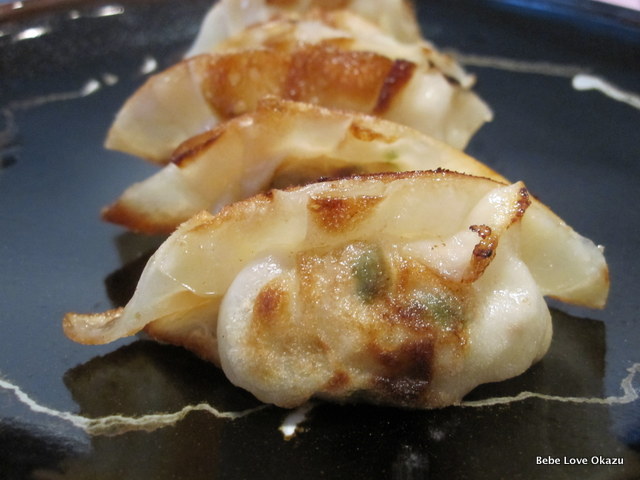
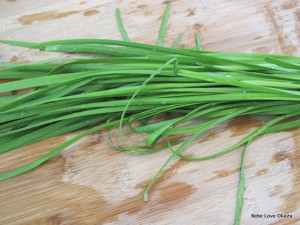
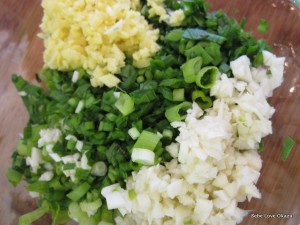
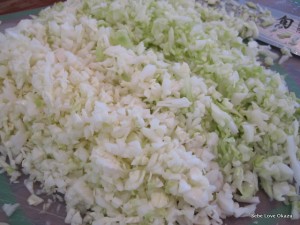

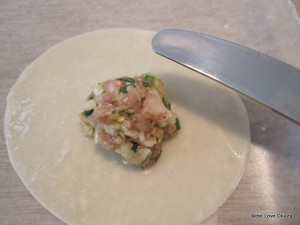
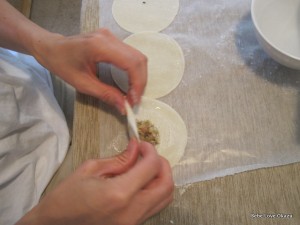
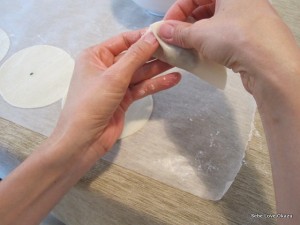

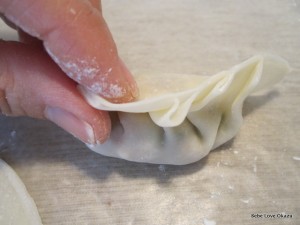

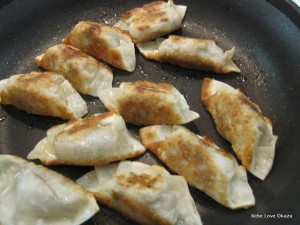
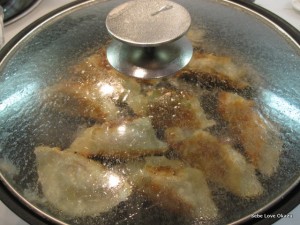
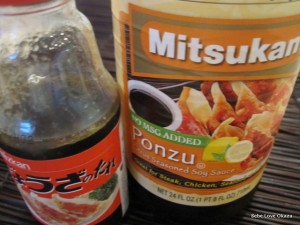
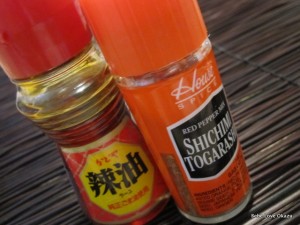

33 Comments